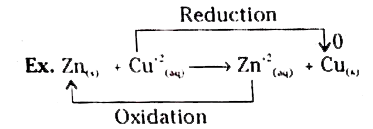Explain the different types of redox reactions.Solution in Telugu
A chemical reaction in which both oxidation and reduction reactions are involved is called an oxidation - reduction reaction or simply a redox reaction.
Ex. 
In this reaction, Zn loses two electrons to form Zn+2 and undergoes oxidation. Cu+2 gains two electrons to form Cu and thus undergoes reduction.
Most of the chemical reactions are redox reactions. These are mainly four types of redox reactions. They are
(a) Chemical combination reactions
(b) Chemical decomposition reactions
( c) Chemical displacement reactions and
(d) Chemical disproportionation reactions
a) Chemical combination reactions :
Ex : Burning of coal in air.
0C(s)+0O2(g)→+4C−2O2(g)
In this reaction the oxidation numbers of carbon and oxygen are zero. In CO2, the oxidation number of 'C' is +4 and that of oxygen is -2. As the oxidation number of carbon increase from 0 to +4, we say that carbon undergoes oxidation. Similarly the oxidation number of oxygen decreases from 0 to -2. Hence the oxygen undergoes reduction. Since this reaction involves both oxidation and reduction, we can infer that the above chemical combination reaction is a redox reaction.
b) Chemical decomposition reactions :
Ex. : Thermal decomposition of mercuric oxide.

In HgO, the oxidation number of Hg is +2 and that of oxygen is -2. The oxidation numbers of free metallic mercury and elemental oxygen are zero. In this reaction Hg undergoes reduction from +2 to 0 and oxygen undergoes oxidation from -2 to 0. The decomposition of HgO involves both oxidation and reduction. Hence, we can infer that the above decomposition reaction is a redox reaction.
c) Chemical displacement reactions :
Ex. Zinc displaces copper from aqueous copper sulphate solution.

In this reaction, the oxidation numbers of elemental zinc and elemental copper are each zero, and the oxidation numbers of Cu and Zn in their aq. solutions are each +2. In this reaction the conversion of Zn into ZnSO4 is oxidation and the conversion of CuSO4 into Cu reduction. Hence, we can infer that the above displacement reaction is a redox reaction.
d) Chemical disproportionation reactions :
Ex. : Chlorine is passed into cold and dilute solution of NaOH.

In this reaction the oxidation number of elemental chlorine is zero. The oxidation number of Cl in NaOCl is (+1) and in NaCl is (-1). In this reaction the same element chlorine has undergone both oxidation and reduction. Here this is a redox reaction.
Topper's Solved these Questions
- BOOK - VGS PUBLICATION-BRILLIANTCHAPTER - STOICHIOMETRYEXERCISE - ADDITIONAL QUESTIONS & ANSWERS10videos
STOICHIOMETRY
- BOOK - VGS PUBLICATION-BRILLIANTCHAPTER - STOICHIOMETRYEXERCISE - SHORT ANSWER QUESTIONS56videos
STOICHIOMETRY
- BOOK - VGS PUBLICATION-BRILLIANTCHAPTER - STATES OF MATTER : GASES AND LIQUIDSEXERCISE - ADDITIONAL QUESTION & ANSWERS10videos
STATES OF MATTER : GASES AND LIQUIDS
- BOOK - VGS PUBLICATION-BRILLIANTCHAPTER - THE P-BLOCK ELEMENTS - GROUP 13 EXERCISE - LONG ANSWER QUESTIONS3videos
THE P-BLOCK ELEMENTS - GROUP 13
Similar Questions
Calculate molecular mass of glucose (C6H12O6) molecule.
View SolutionThe approximate production of sodium carbonate per month is 424×106g. While that of methyl alcohol is 320×106 gm. Which is produced more in terms of moles ?
View SolutionA balloon is filled with hydrogen at room temperature. It will burst if pressure exceeds 0.2 bar, If at 1 bar pressure the gas occupies 2.27 L volume, upto what volume can the balloon be expanded?
03:06View SolutionHow are borax and boric acid prepared ? Explain the action of heat on them.
02:42View SolutionExplain redox reaction with suitable example.
09:06View SolutionExplain redox reaction with suitable example.
02:46View SolutionExplain applications of Redox Reactions?
01:21:11View SolutionExplain the criteria for feasibility of redox reaction.
01:08:48View SolutionExplain the different types of redox reactions with example.
04:26View Solutionవివిధ రకాల ఆక్సీకర, క్షయకరణ (రెడాక్స్) చర్యలను వివరించండి.
View SolutionDifferent types of Redox Titration
06:03View SolutionBalancing of Redox Reactions | Redox Titrations | Types of Redox Reactions | Oxidation state and its calculations
05:02View SolutionExplain any two types of redox reactions with examples.
33:53View SolutionDiscuss the types of redox reactions in detail ?
46:37View SolutionRedox reactions are those in which oxidation and reduction takes places. Explain the different types of redox reactions with suitable examples
01:02:53View Solution

